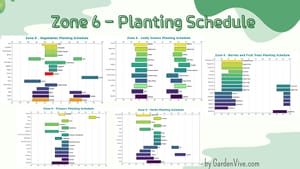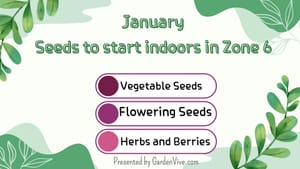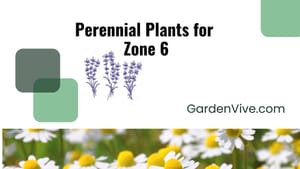
USDA Zone 6 is still too cold to plant something outside in February, but we have plenty of seed choices to start indoors. In this article, you will find what seeds to start indoors in February in Zone 6.
Note: Not every plant seed has the same germination time and optimal germination temperature.
This is why I will be sharing all the necessary information in my charts. You will get everything you need to start the seeds indoors in this cold.
To increase the readability I would be sharing multiple charts. You will get the charts by categories:
- Vegetable seeds to start
- Flowering seeds
- Herbs
- Berries
I will not recommend planting anything outside at this moment.
Due to the heavy cold, you may find the list is shorter than most of my other planting charts. You are free to experiment planting something else not mentioned in my list.
Vegetable Seeds to Start Indoors in Zone 6 - February
| Vegetable | Germination Time | Optimal Germination Temp. | Variety Suggestions | Transplanting Time |
|---|---|---|---|---|
| Tomatoes | 5-10 days | 21-27°C (70-80°F) | Brandywine, Roma, Sungold | After last frost (mid to late May) |
| Peppers | 7-14 days | 24-30°C (75-86°F) | California Wonder, Jalapeño, Bell Boy | After last frost (mid to late May) |
| Eggplant | 7-14 days | 24-30°C (75-86°F) | Black Beauty, Long Purple, Rosa Bianca | After last frost (mid to late May) |
| Broccoli | 4-7 days | 18-24°C (65-75°F) | Calabrese, Waltham 29, Green Magic | 4-6 weeks before last frost (early April) |
| Cabbage | 4-10 days | 18-24°C (65-75°F) | Golden Acre, Red Express, Savoy | 4-6 weeks before last frost (early April) |
| Kale | 5-8 days | 18-24°C (65-75°F) | Lacinato, Red Russian, Winterbor | 4-6 weeks before last frost (early April) |
| Onions | 7-10 days | 18-22°C (65-72°F) | Walla Walla, Red Baron, Yellow Sweet Spanish | 4-6 weeks before last frost (early April) |
| Leeks | 7-14 days | 18-24°C (65-75°F) | King Richard, American Flag, Carentan | 4-6 weeks before last frost (early April) |
| Celery | 14-21 days | 18-24°C (65-75°F) | Tall Utah, Golden Self-Blanching, Tango | After last frost (mid to late May) |
| Cauliflower | 8-10 days | 18-24°C (65-75°F) | Snowball, Cheddar, Graffiti | 4-6 weeks before last frost (early April) |
Grow lights are not necessary for seed germination always. It depends on which plant it is.
- Tomatoes
- Peppers
- Eggplants
- Broccoli
- Cabbage
- Cauliflower
- Onions
- Leeks
- Celery
The above-mentioned plant seeds germinate in darkness, but they will need light once they sprout.
And there are some plant seeds that need light from the start to sprout properly. For example: Lettuce, Basil, Chamomile.
If you are annoyed by deer in your garden, check: deer resistant plants for Zone 6
Flowering plants
| Flower | Germination Time | Optimal Germination Temp. | Perennial/Annual | Transplanting Time |
|---|---|---|---|---|
| Petunia | 7-14 days | 21-27°C (70-80°F) | Annual | After last frost (mid to late May) |
| Marigold | 4-7 days | 21-24°C (70-75°F) | Annual | After last frost (mid to late May) |
| Zinnia | 5-7 days | 21-26°C (70-78°F) | Annual | After last frost (mid to late May) |
| Lupine | 14-30 days | 18-24°C (65-75°F) | Perennial | 2-4 weeks before last frost (April) |
| Snapdragon | 10-14 days | 18-21°C (65-70°F) | Annual | 2-4 weeks before last frost (April) |
| Echinacea (Coneflower) | 10-20 days | 18-24°C (65-75°F) | Perennial | After last frost (mid to late May) |
| Delphinium | 14-28 days | 15-21°C (60-70°F) | Perennial | 2-4 weeks before last frost (April) |
| Lavender | 14-28 days | 18-21°C (65-70°F) | Perennial | After last frost (mid to late May) |
| Black-eyed Susan | 7-30 days | 18-24°C (65-75°F) | Perennial | After last frost (mid to late May) |
| Verbena | 14-28 days | 18-24°C (65-75°F) | Annual | After last frost (mid to late May) |
Love perennial plants? Take a look at this chart: Perennial plants for Zone 6
Herbs to plant indoors in Zone 6 - February
| Herb | Planting Method | Transplanting Time (if applicable) | Variety Suggestions |
|---|---|---|---|
| Parsley | Start from seed | After last frost (mid-May) | Italian Flat-Leaf, Curly, Giant of Italy |
| Thyme | Start from seed or cuttings | After last frost (mid-May) | English, Lemon, Creeping |
| Oregano | Start from seed or division | After last frost (mid-May) | Greek, Italian, Hot & Spicy |
| Chives | Start from seed or division | After last frost (mid-May) | Garlic, Common, Siberian |
| Sage | Start from seed or cuttings | After last frost (mid-May) | Common, Purple, Golden |
Do not try to grow basil as that is sensitive to cold.
Berries
| Berry | Planting Method | Transplanting Time | Harvesting Time | Variety Suggestions |
|---|---|---|---|---|
| Strawberries | Start from bare roots or runners | Early spring (March-April) | June - September | Albion, Seascape, Chandler |
| Raspberries | Start from bare root canes | Early spring (March-April) | Summer - Fall | Heritage, Fall Gold, Caroline |
| Blueberries | Start from container-grown plants | Spring (April-May) | June - August | Bluecrop, Patriot, Duke |
| Blackberries | Start from bare root canes | Early spring (March-April) | July - September | Triple Crown, Arapaho, Chester |
| Gooseberries | Start from bare roots or cuttings | Early spring (March-April) | June - August | Invicta, Hinnomaki Red, Captivator |
| Currants | Start from bare roots or cuttings | Early spring (March-April) | June - July | Red Lake, Consort, Titania |
If you are a beginner gardener then wait for the next month to start planting.
Find it helpful? Share with other Zone 6 gardeners.
Subscribe to this site and motivate me to bring more content like this.






